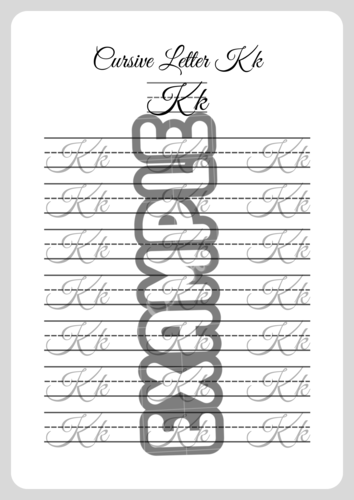
Transform your text into 96 unique styles across 12 categories!
Writing a cursive capital 'K' involves a specific set of strokes to create a smooth and connected script. Here's a step-by-step guide on how to write a cursive capital 'K':

Begin slightly above the line where you want the 'K' to rest. Make a diagonal stroke from the top left to the bottom right.
Start with a small loop or curve at the top, then make a diagonal stroke from the top right to the bottom left. Finish with a small loop or curve at the bottom.
Ensure a smooth transition when connecting 'K' with other letters by maintaining a continuous flow between the diagonal strokes and loops.
Tip 1: Practice the distinct strokes and loops of both uppercase and lowercase 'k' for consistency in your cursive writing.
Tip 2: Pay attention to the proportions of the loops and diagonal strokes in 'K' for balance.
Tip 3: Experiment with the size and slant of your cursive 'K' to find a style that suits your preferences while maintaining legibility.
If you are looking for a Cursive K worksheet in PDF format, you can find and download it. This online resource offers a free PDF worksheet that includes both uppercase and lowercase Cursive K letters for practice.

When learning how to write k in cursive, it's important to begin with the basic strokes that define the letter’s unique structure. Practice how to make a cursive k by focusing on creating smooth, connected lines that flow naturally. Mastering the capital K cursive style will add a touch of elegance and sophistication to your handwriting.
To perfect your cursive capital K, pay attention to the proportions and loops that make the letter stand out. Practicing the lower case cursive k will help you maintain a consistent and cohesive writing style. Developing a strong cursive uppercase K will enhance the formal appearance of your cursive writing, making it suitable for important titles and documents.
For a more personalized look, experiment with the capital letter K cursive style by adding unique embellishments and flourishes. Creating a fancy cursive k can give your handwriting an artistic flair. Using a capitalized cursive K will ensure a professional and polished appearance in your work. Additionally, cursive k copy and paste options offer convenience for quickly replicating your beautifully crafted letters across different projects.
Cursive writing, with its flowing and graceful strokes, has long been admired for its elegance and sophistication. Among the letters that compose the cursive alphabet, the letter "k" holds a special allure with its unique loops and curves. Mastering the k in cursive lowercase is essential for anyone aspiring to excel in cursive writing. The lowercase k in cursive begins with a smooth upward stroke from the baseline, followed by a loop that curves to the right and then descends below the baseline before looping back up with a slight flick to the left. This fluid motion not only enhances the visual appeal of the letter but also ensures it connects seamlessly with the next letter, maintaining the continuous flow characteristic of cursive writing.
Transitioning to the cursive k uppercase, the design becomes more intricate and refined. The capital k in cursive is crafted with a bold initial stroke that rises vertically from the baseline and then curves into a large loop, sweeping gracefully downward and to the right before curling back up and around. This ornate design makes the cursive k uppercase stand out prominently at the beginning of sentences or proper nouns, adding a touch of elegance and prominence to any text. The distinction between the cursive k uppercase and its lowercase counterpart lies in its additional flourishes and loops, which contribute to its grandeur and sophistication.
Mastering the cursive k lowercase is crucial for achieving fluency in cursive writing. The k in cursive lowercase must be crafted with precision to ensure it connects smoothly to other letters in a word. This connectivity is a defining feature of cursive writing, making it both practical for continuous writing and visually harmonious. The elegance of the lowercase k in cursive lies in its simplicity and the ease with which it can be written once mastered, allowing writers to maintain a steady flow without lifting the pen from the paper. This fluidity is what makes cursive writing so distinctive and admired.
Practicing the cursive k uppercase requires patience and attention to detail. The capital k in cursive is not only larger but also includes more intricate details, making it a bit more challenging to master. However, once perfected, it adds significant elegance to any piece of writing. The beauty of the cursive k uppercase is particularly evident in formal documents and artistic calligraphy, where its ornate design can be fully appreciated. Its grand loops and sweeping curves make it a standout element in any text, enhancing the overall aesthetic of the written piece.
In conclusion, mastering both the k in cursive lowercase and the cursive k uppercase is essential for anyone looking to enhance their cursive writing skills. Each letter, whether it’s the lowercase k in cursive or the capital k in cursive, brings its unique charm and complexity to the writing. By practicing these letters, one can achieve a higher level of fluency and elegance in their cursive writing. The cursive k lowercase helps maintain the fluidity and continuity of the text, while the cursive k uppercase adds a touch of distinction and sophistication. Together, they showcase the beauty and versatility of cursive writing, making it a timeless and valuable skill to acquire. As with any art form, the key to mastering cursive lies in consistent practice and a deep appreciation for the aesthetic qualities of each letter.